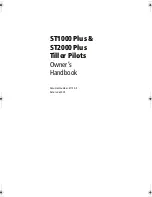
• You MUST fit a suitably rated fuse or breaker
between the red wire and the battery’s positive
terminal.
• Refer to the inline fuse ratings provided in the
product’s documentation.
• If you need to extend the length of the power
cable, ensure you use suitably rated cable and
that sufficient power (12 V dc) is available at the
SeaTalk
ng®
backbone’s power connection.
D13344-1
A
B
A
Battery connection scenario A: suitable for a vessel with
a common RF ground point. In this scenario, if your
product’s power cable is supplied with a separate drain
wire then it should be connected to the vessel’s common
ground point.
B
Battery connection scenario B: suitable for a vessel
without a common grounding point. In this case, if your
product’s power cable is supplied with a separate drain
wire then it should be connected directly to the battery’s
negative terminal.
Implementation — connection to distribution
panel
D13348-1
• Alternatively, the
SeaTalk
ng®
power cable may be
connected to a suitable breaker or switch on the
vessel's distribution panel or factory-fitted power
distribution point.
• The distribution point should be fed from the
vessel’s primary power source by 8 AWG
(8.36 mm
2
) cable.
• Ideally, all equipment should be wired to individual
suitably-rated thermal breakers or fuses, with
appropriate circuit protection. Where this is not
possible and more than 1 item of equipment
shares a breaker, use individual in-line fuses
for each power circuit to provide the necessary
protection.
• In all cases, observe the recommended
breaker / fuse ratings provided in the product’s
documentation.
• If you need to extend the length of the power
cable, ensure you use suitably rated cable and
that sufficient power (12 V dc) is available at the
SeaTalk
ng®
backbone’s power connection.
Important:
Be aware that the suitable fuse rating
for the thermal breaker or fuse is dependent on the
number of devices you are connecting.
More information
Raymarine recommends that best practice is
observed in all vessel electrical installations, as
detailed in the following standards:
• BMEA Code of Practice for Electrical and
Electronic Installations in Boats
• NMEA 0400 Installation Standard
• ABYC E-11 AC & DC Electrical Systems on Boats
• ABYC A-31 Battery chargers and Inverters
• ABYC TE-4 Lightning Protection
Sharing a breaker
Where more than 1 piece of equipment shares a
breaker you must provide protection for the individual
circuits. E.g. by connecting an in-line fuse for each
power circuit.
D11637-2
2
4
4
1
3
+
-
1
Positive (+) bar
2
Negative (-) bar
3
Circuit breaker
4
Fuse
Where possible, connect individual items of
equipment to individual circuit breakers. Where this
is not possible, use individual in-line fuses to provide
the necessary protection.
Warning: Product grounding
Before applying power to this product,
ensure it has been correctly grounded, in
accordance with the instructions provided.
Warning: Positive ground systems
Do not connect this unit to a system which
has positive grounding.
24
p70 / p70R
Содержание P70
Страница 2: ......
Страница 4: ......
Страница 10: ...10 p70 p70R ...
Страница 14: ...14 p70 p70R ...
Страница 28: ...28 p70 p70R ...
Страница 29: ...Chapter 5 Installation Chapter contents 5 1 Mounting on page 30 Installation 29 ...
Страница 38: ...38 p70 p70R ...
Страница 48: ...48 p70 p70R ...
Страница 58: ...58 p70 p70R ...
Страница 68: ...68 p70 p70R ...
Страница 74: ...74 p70 p70R ...
Страница 75: ...Chapter 11 Pilot controller alarms Chapter contents 11 1 Alarms on page 76 Pilot controller alarms 75 ...
Страница 80: ...80 p70 p70R ...
Страница 94: ...94 p70 p70R ...
Страница 110: ...110 p70 p70R ...
Страница 118: ...118 p70 p70R ...
Страница 121: ......
















































